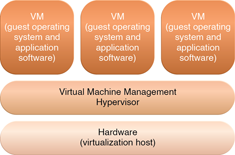Hardware-based and Operating System-based Virtualization
Operating System-based Virtualization
Operating system-based virtualization is the installation of virtualization software in a pre-existing operating system, which is called the host operating system (Figure 1). For example, a user whose workstation has a specific version of Windows installed decides it wants to generate virtual machines. It installs the virtualization software into its host operating system like any other program and uses this application to generate and operate one or more virtual machine. This user needs to use its virtualization software to enable direct access to any of the generated virtual machines. Since the host operating system can provide hardware devices with the necessary support, operating system virtualization can rectify hardware compatibility issues even if the hardware driver is unavailable to the virtualization software.
Hardware independence that is enabled by virtualization allows hardware IT resources to be more flexibly used. For example, let’s take a scenario in which the host operating system has the software necessary for controlling five network adapters that are available to the physical computer. The virtualization software can make the five network adapters available to the virtual machine, even if the virtualized operating system is usually incapable of physically housing five network adapters.

Figure 1 – The different logical layers of operating system-based virtualization, in which the VM is first installed into a full host operating system and subsequently used to generate virtual machines.
Virtualization software translates hardware IT resources that require unique software for operation into virtualized IT resources that are compatible with a range of operating systems. Since the host operating system is a complete operating system in itself, many operating system-based services that are available as organizational management and administration tools can be used to manage the virtualization host.
Examples of such services include:
- Backup and Recovery
- Integration to Directory Services
- Security Management
Operating system-based virtualization can introduce demands and issues related to performance overhead, such as:
- The host operating system consumes CPU, memory, and other hardware IT resources.
- Hardware-related calls from guest operating systems need to traverse several layers to and from the hardware, which decreases overall performance.
- Licenses are usually required for host operating systems, in addition to individual licenses for each of their guest operating systems.
A concern with operating system-based virtualization is the processing overhead required to run the virtualization software and host operating systems. Implementing a virtualization layer will negatively affect overall system performance. Estimating, monitoring, and managing the resulting impact can be challenging because it requires expertise in system workloads, software and hardware environments, and sophisticated monitoring tools.
Hardware-based Virtualization
This option represents the installation of virtualization software directly on the virtualization host hardware so as to bypass the host operating system, which would presumably be engaged with operating system-based virtualization (Figure 2). Allowing the virtual machines to interact with hardware without requiring intermediary action from the host operating system generally makes hardware-based virtualization more efficient.

Figure 2 – The different logical layers of hardware-based virtualization, which does not require another host operating system.
Virtualization software is typically referred to as a hypervisor for this type of processing. A hypervisor has a simple user interface that requires a negligible amount of storage space. It exists as a thin layer of software that handles hardware management functions to establish a virtualization management layer. Device drivers and system services are optimized for the provisioning of virtual machines, although many standard operating system functions are not implemented. This type of virtualization system is essentially used to optimize performance overhead inherent to the coordination that enables multiple VMs to interact with the same hardware platform.
One of the main issues of hardware-based virtualization concerns compatibility with hardware devices. The virtualization layer is designed to communicate directly with the host hardware, meaning all of the associated device drivers and support software must be compatible with the hypervisor. Hardware device drivers may not be as available to hypervisor platforms as they are to more commonly used operating systems. Also, host management and administration features may not include the range of advanced functions that are common to operating systems.
